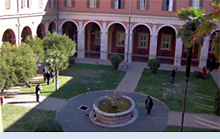 |
European Planetary Science Congress 2010
Angelicum Centre – Pontifical University of Saint Thomas Aquinas
19 – 24 September 2010, Rome, Italy |
 |
|
OEA3 Probing the atmospheres of extrasolar worlds: from gas-giants to Super-Earths |
| Convener: Giovanna Tinetti |
|
Oral Program
/ Fri, 24 Sep, 15:30–18:30
/ Room Lecture Room 2
Poster Program
/ Attendance Thu, 23 Sep, 17:30–19:00
/ Poster Area
|
More than 450 exoplanets, i.e. planets orbiting a star different from our Sun, are now known thanks to indirect detection techniques. In the first decade after their initial discovery in 1995 by Mayor and Queloz, the task was to find more and more of these astronomical bodies: the biggest, the smallest; the hottest, the coolest. In recent years, attention has switched from finding planets to characterising them. Among the variety of exoplanets discovered so far, special attention is devoted to those planets which transit their parent star. Most recent observations with Hubble and Spitzer Space Telescopes or from the ground, in fact, have proved being possible to use the wavelength/time dependence of the combined light star-planet to identify key chemical components and the thermal structure of the planet’s atmosphere. Spectra of young gas-giants at large separation from the star are also being obtained from the ground. These planets are unsuitable for life, but the next generation of space and ground telescopes will guarantee the characterisation of fainter targets, in particular large terrestrial planets (Super-Earths) in the habitable zone of select classes of stars.

